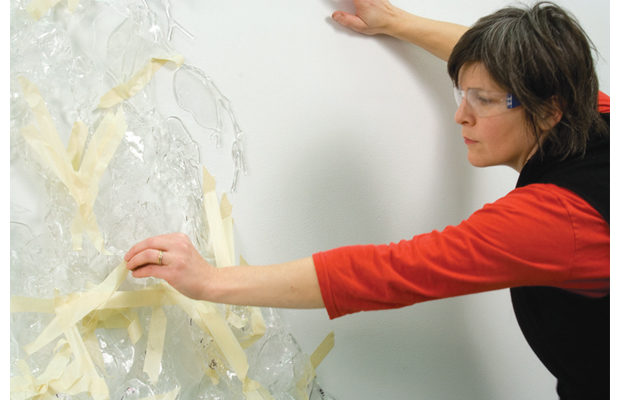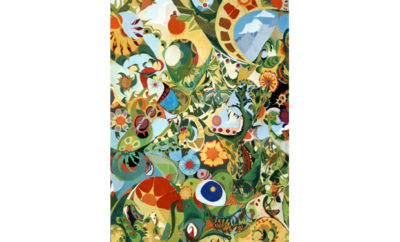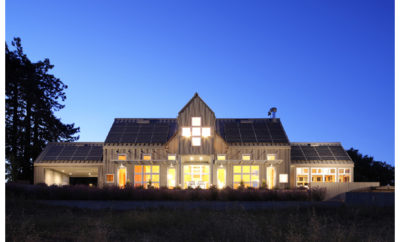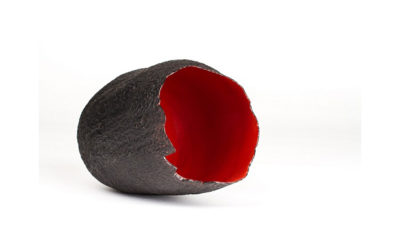
Feature
Through the Looking Glass
Through her shimmering compositions in glass, Beth Lipman conjures up worlds old and new, delicate and muscular
HOW DO YOU GET INSIDE A PICTURE and what can you do there? These are questions a child asks and an adult struggles to answer. A picture, of course, is an illusion. You get inside through imagination. Once there, you might assume it’s full of words since objects tell stories.
Beth Lipman is an artist who became interested in the world of pictures, particularly by those Italian and Dutch painters whose still lifes depict a compendium of natural and inanimate objects at rest. Her medium is glass. As she has explained, “I use blowing, solid sculpting, kiln-forming, lampworking. I paint on the glass with craft paint, I glue it together with silicone, I do whatever it takes to create the object.” Inspired by the narratives of the early masters, she began making goblets, jars, cups, bottles, and bowls—traditional vessels that glassmakers have been crafting since ancient times—as well as virtuosic life-sized sculptured glass fruit and flowers, fish and fowl, which she arranges and affixes on wooden table tops. The result: giant, three-dimensional still lifes, transparent renderings of material once stuck inside a picture plane. By translating the flat painted objects and coaxing them into architectural space, the artist facilitates conversations about consumption and identity, beauty and perishability, perfection and imperfection, abundance and excess, patience and cruelty.

Beth Lipman’s Laid (Time-) Table with Cycads, 2015.
I had the pleasure of viewing Laid (Time-) Table with Cycads, Lipman’s tour-de-force installation at the Claire Oliver Gallery in Chelsea this spring. Planning for the work began in 2013 and it’s a culmination of Lipman’s exploration of the still-life form with hundreds of glass pieces referencing objects from both the Dutch golden age and the Victorian era and then going forward into our time. (I was told they unpacked 163 boxes of material for the installation, which took three and a half days to put together.) Plates and glasses, flasks, chalices, pitchers, jars and decanters, eggs, oysters, lemons, raspberries, mint sprigs, tulips, rope, books, pencils, a writing pad, swatch of cloth, a viola, a gazing ball, bread loaves, hot cross buns, keys, an ax, a gun, boxes of beads and boxes of pins, an apothecary jar—all mounded in disarray and glued in place across a sixteen-foot-wide wooden table. Diligent viewers, responding to the natural tendency of glass to refract and reflect light, must play a guessing game, decoding a mass of flowers and fruit in what the artist calls a wilted topiary, or the partially concealed gun and ax. Other objects are broken and hang over the table edges like half-destroyed artifacts of cataclysm (the plates look like broken flying saucers). Beneath the table, the floor is blanketed by a glass jungle of entwined prehistoric plants: ferns, mosses, cycads, and ginkgos, riotous patterns of fronds and leaves, some spiking, some exhibiting an almost snowflake-like symmetry. The thick trunks of the cycads appear to have pierced the table in three places so that crowns of radiating, palm-like leaves stretch above and across the chaotic collection, invading the domestic objects.
The shimmering glass, like rock crystal or icicles, is beautiful and ethereal, drawing you into a scene that might otherwise be too punishing to approach. Though the narrative is calamitous—a dramatic, almost melodramatic, meditation on material excess and the horror of extinction—you also get a sense of the artist at play (something akin to a child making vinegar and baking soda volcanoes). Asked what part of the creative process she enjoys the most, Lipman says, “It changes daily depending on the circumstances. I definitely am submerged in creating the compositions. Sometimes I take great pleasure in creating the individual components and sometimes I don’t. The most exciting times are the epiphanies, when it’s apparent how to take the big step forward.” Does she have the urge to change things after they’re set? She thinks of the completed works as “finished drawings…but I’m open to change during the course of the lifetime of the work. Each time the work is installed it changes slightly; also if things break I tend to use those moments as opportunities to further the concept of the work, by including the components in their imperfect state or ‘healing’ the component by gluing it back together, although the scar always remains. All of these processes are analogies for life.”

Lipman’s glass reinterpretations of nineteenth-century sideboard, a Victorian crib, and a Shaker cradle draw attention to the cycle of life and the perishability of material in Precarious Possessions, an installation at the John and Mable Ringling Museum of Art in Sarasota, Florida, 2014.
Cut Table, an installation on view at the Museum of Fine Arts, Boston, until January 10, 2016, distills some of Lipman’s thoughts about a sublime grace in the ruin of things. Here she’s assembled a jumble of glass objects, cylinders and spheres, candlesticks, a flute, an apothecary jar, stacked bowls and dishes, some of them already broken. At first glance, everything appears shimmering and lustrous, but as the eye adjusts, you see that the table has been cut and the glass damask-style “wallpaper” in the background is frayed. The injuries of time seem to have left their mark on the surfaces of these ordinary things, which are simultaneously shining and translucent, damaged, unstable, and impermanent.
When the New Britain Museum of American Art commissioned her to create a work of art inspired by the collection, Lipman turned to Thomas Hart Benton’s The Art of Life in America murals, extracting a cluster of objects—playing cards, a ukelele, liquor flask, pistol, rifle, wine jug, tabor pipe—to transfer into glass. Part of the delight of the piece comes from that initial transformation, the artistry of changing Benton’s dynamic palette into clear glass. By releasing the objects from the picture frame, Lipman compresses Benton’s epic tale of greed, waste, and excess into its essence. Staged on and around a roughened glass pulpit with glass wallpaper of a willow tree for scenery, the objects stand in for Benton’s crowd of bootleggers, gamblers, and frontiersmen.

The dramatic force of the frontiersmen and gamblers in Thomas Hart Benton’s The Art of Life in America murals is condensed in Lipman’s Aspects of (American) Life, commissioned by the New Britain Museum of American Art in Connecticut, which also owns the murals, 2014
In a recent installation in the wood-paneled period rooms of the Ringling Museum in Florida, Precarious Possessions: Crib, Cradle and Sideboard with Blue China, Lipman portrays the three stages of life with full-sized glass re-creations of furniture. The crib and cradle represent the beginning and end of life—the cradle modeled on a rocking bed once used by the Shakers to soothe the sick or elderly, protecting them from drafts and bed sores. The artist has cut off the legs and part of the side frame and slats at the footboard end of the crib so that it appears to be sinking into unstable ground. In its simplicity, the unadorned cradle is only one remove from a casket. The elusive quality, the fragility, of the glass and the juxtaposition of the empty pieces remind us that the body is mortal. Perhaps we compensate for this realization by acquiring material objects, but the furnishings are meant to raise the question that Lipman herself asks: “What kind of comfort” does that bring, or “perhaps doesn’t bring us?”

Cut Table, 2014, is on view at the Museum of Fine Arts, Boston, until January 10, 2016.
The third piece, Sideboard with Blue China, signifies the central period of life as a time of bounty. Inspired by a grand buffet by the nineteenth-century American furniture firm of Erastus Bulkley and Gustave Herter, the sideboard, measuring sixteen feet long, has a heroic quality to it. The wall behind it is finished with a wallpaper of flowers and branching trees made from blown, lampworked, and kiln-formed glass. Lipman talks of the sideboard as a vanity piece that traditionally symbolized the prosperity of the house. It was where the master carved the meat, and bowls would be overflowing with fruit and flowers. Historians write about the Victorian cabinet as a portrait of its owner and a projection of the family’s material prosperity, with carvings of fish, rabbits, fowl, and even guns fashioned into the ornament. Lipman has incorporated much of that iconography in her re-imagined cabinetry and even installed a glass eagle at the very top center of the piece. While the sideboard was conceived as a metaphor for splendid excess, it evolved into an examination of identity and the darker meaning of consumption and waste, of wasting and dying. With this in mind, Lipman mixed the standard Victorian iconography, symbols of the hunt and fishing, with fragments of human anatomy—hands, legs, reproductive organs, a heart, a brain. While the glass naturally confuses the eye, the conjoining of the bountiful material world with elements of the human figure is unexpected and destabilizing. The frustrated eye glances across the cabinet doors trying to distinguish between icons of abundance and the macabre amid surfaces that look like flattened silicified fossils.

In One and Others, in the collection of the Norton Museum of Art, West Palm Beach, Florida, 2011, Lipman has spread glass objects over a casket like a spray of funeral flowers. Three gazing balls, sometimes known as witch balls, are intended to ward off harmful spirits.
Much of Lipman’s art can be seen as a meditation and translation of the Dutch proverb “In luxury, look out,” but her glasswork also reminds us of our love of looking. The Dutch artists who first inspired her laid tables were also fascinated by seeing, by optics and illusion, the lens, the mirror, and reflections in a glass ball. In recent works, Lipman has introduced the gazing ball into her collection of curiosities. Hand blown, mirrored, and varnished on the exterior, the gazing ball adds another dimension of artistic virtuosity. Historically intended to be placed in a garden for the sun to play upon, in a still life it acts as an eye that shows you what the artist has seen. It can reflect your face (or the artist’s face). It can be a metaphor of the seeing self and of consciousness while playfully distorting the physical surroundings, teasing straight lines into curves and bending perspective. In One and Others at the Norton Museum of Art, Lipman has covered the top of a black casket with a heap of idiosyncratic glass objects—drinking vessels, pineapples, a ball and chain, flower swags, a dead rabbit, rolled-up table cloth, candelabra, and three gazing balls, here intended to ward off harmful spirits. She calls the work “a composite portrait”; the casket was measured to her own dimensions. The gazing balls, balanced in candle holders, create pyrotechnics as light bounces off them onto the heap of glass detritus and boomerangs back.
During a residency in Alaska last summer, Lipman used a gazing ball and camera to contemplate changing light and passing clouds, an enterprise the Dutch masters would have approved, and a project that took her out of domestic interiors and into open air and wilderness. As part of a series of reversals, the gazing ball, a handcrafted and imperfect glass object, became a collector of landscape. Placed on the forest floor or in a candle cup on the beach, the old describing tool proffered information about plant life, horizon, and sky—the challenge of how to get inside the picture plane turned inside out.












